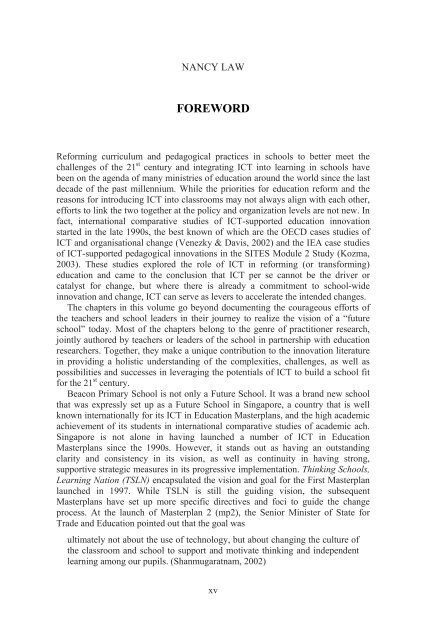1517-creating-holistic-technology-enhanced-learning-experiences
1517-creating-holistic-technology-enhanced-learning-experiences
1517-creating-holistic-technology-enhanced-learning-experiences
You also want an ePaper? Increase the reach of your titles
YUMPU automatically turns print PDFs into web optimized ePapers that Google loves.
NANCY LAW<br />
FOREWORD<br />
Reforming curriculum and pedagogical practices in schools to better meet the<br />
challenges of the 21 st century and integrating ICT into <strong>learning</strong> in schools have<br />
been on the agenda of many ministries of education around the world since the last<br />
decade of the past millennium. While the priorities for education reform and the<br />
reasons for introducing ICT into classrooms may not always align with each other,<br />
efforts to link the two together at the policy and organization levels are not new. In<br />
fact, international comparative studies of ICT-supported education innovation<br />
started in the late 1990s, the best known of which are the OECD cases studies of<br />
ICT and organisational change (Venezky & Davis, 2002) and the IEA case studies<br />
of ICT-supported pedagogical innovations in the SITES Module 2 Study (Kozma,<br />
2003). These studies explored the role of ICT in reforming (or transforming)<br />
education and came to the conclusion that ICT per se cannot be the driver or<br />
catalyst for change, but where there is already a commitment to school-wide<br />
innovation and change, ICT can serve as levers to accelerate the intended changes.<br />
The chapters in this volume go beyond documenting the courageous efforts of<br />
the teachers and school leaders in their journey to realize the vision of a “future<br />
school” today. Most of the chapters belong to the genre of practitioner research,<br />
jointly authored by teachers or leaders of the school in partnership with education<br />
researchers. Together, they make a unique contribution to the innovation literature<br />
in providing a <strong>holistic</strong> understanding of the complexities, challenges, as well as<br />
possibilities and successes in leveraging the potentials of ICT to build a school fit<br />
for the 21 st century.<br />
Beacon Primary School is not only a Future School. It was a brand new school<br />
that was expressly set up as a Future School in Singapore, a country that is well<br />
known internationally for its ICT in Education Masterplans, and the high academic<br />
achievement of its students in international comparative studies of academic ach.<br />
Singapore is not alone in having launched a number of ICT in Education<br />
Masterplans since the 1990s. However, it stands out as having an outstanding<br />
clarity and consistency in its vision, as well as continuity in having strong,<br />
supportive strategic measures in its progressive implementation. Thinking Schools,<br />
Learning Nation (TSLN) encapsulated the vision and goal for the First Masterplan<br />
launched in 1997. While TSLN is still the guiding vision, the subsequent<br />
Masterplans have set up more specific directives and foci to guide the change<br />
process. At the launch of Masterplan 2 (mp2), the Senior Minister of State for<br />
Trade and Education pointed out that the goal was<br />
ultimately not about the use of <strong>technology</strong>, but about changing the culture of<br />
the classroom and school to support and motivate thinking and independent<br />
<strong>learning</strong> among our pupils. (Shanmugaratnam, 2002)<br />
xv


